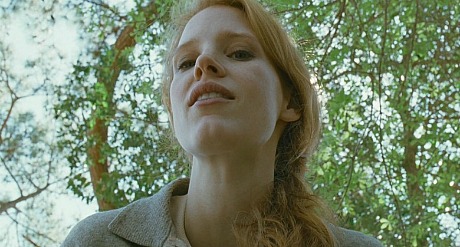I was stirred and intrigued and frequently taken away by portions of Terrence Malick‘s The Tree of Life when I saw it in Cannes. So when friends told me they planned to see it last night it suddenly seemed like a good idea to join them. But now, 12 hours after the lights came up in Arclight #5, I’m not so sure.

Jessica Chastain in The Tree of Life
Life is still a gentle, layered, highly undisciplined cosmic church-service movie — a quiet spiritual environment to dream inside of and meditate by. But (and I’m sorry to say this in a way) it doesn’t gain with a second viewing. And all very good or great movies tend to do this. So what’s wrong?
I was made fun of on 5.22 by New York‘s “Approval Matrix” guy for tweeting from Cannes that I was glad I’d seen The Tree of Life but I’m “not sure if I’ll buy/get the Bluray.” Now that I’ve seen it twice I know I won’t bring the Bluray home. In other words I immediately sensed it wasn’t a two-timer in Cannes and now the proof is in the pudding, so I would say my premonitions have merit.
For me, The Tree of Life is an amazing film in the sense that it gathers and swirls it all together in the same way that I myself swirl it all together ever day, soaking in my blender shake of childhood memories, present-day ennui, seaside dreams, forest-primeval dreams and dinosaur dreams, catch-as-catch-can impressions and endless variations and meditations about loss and lament and the absence of grace, etc. That plus “fuck me because it sure could have been a happier life if it hadn’t been for my gruff, largely unaffectionate, World War II-generation dad who brought darkness and snippiness too many times to the dinner table,” etc.
I’m always disengaging from the present and wandering around in the past and thinking about dinosaurs and Dean Martin and Steve McQueen and Lee Marvin and cap guns and girls in bikinis on beaches and how my mother looked and sounded when she was young, and how I used to argue with myself about who was worse, she or my father. All I know is that except for movie-watching and running around with friends, my childhood was a Soviet prison-camp experience — a spiritual gulag. My parents and the public schools I attended may have made me into a tougher, more resourceful survivor than if they’d been “nicer” and easier on me, but God, what a price.
I’m presuming it’s not just me who takes this head-trip all the time, but each and every person on the planet. Malick is merely taking a grab-bag of his own lamentings and assembling them into a film. That — don’t get me wrong — is a very welcome thing. I’m immensely grateful that a film as nourishing and open-pored as The Tree of Life is playing in the same plex alongside Transformers 3 (a film that gives you no room whatsoever to trip out).
But I’m not convinced that what Malick has done is all that staggering or transcendent or worth the kind of in-depth explanation piece that Salon‘s Matt Zoller Seitz has written, which reminds me of the sermons that Episcopalian ministers used to deliver when they tried to explain what God and Jesus could or should mean to the average parishioner (i.e., myself). I used to quietly groan to myself during these sermons, and then I took LSD when I was 19 and I finally did see God and Jesus, and I realized what tepid and cautious fellows those ministers were.
I’m basically saying that my second Life experience was the same exquisitely captured, three-card-monte salad toss. The dreams and ennui of Mr. Malick when he first hatched the idea back in the ’70s (when it was called Q) + the joy and wonder of Emmanuel Lubezki‘s cinematography + Malick’s “I’ll figure it out during editing” strategy. Many an ambitious and/or captivating film could be described as being “less about itself than what you the viewer would make of it,” but The Tree of Life is especially that kind of film. You’re on your own, baby.
My first Cannes tweet still says it all: “Terrence Malick made The Tree of Life in this free-flowing, free-associative way because he could, because he doesn’t have Bert and Harold Schneider riding his ass in post, and because God told him to…like it or lump it.”
The other problem was last night’s Arclight showing was projected with insufficient light and with a slightly hazy focus. Malick asked projectionists for 14 foot lamberts of light when showing his film. I knew right away I was looking at something like 10 or 11 foot lamberts…somewhere in that vicinity. Not terrible but not enough. Some if not much of the subtleties in Lubezki’s visual scheme are simply not manifested when the brightness levels aren’t full-on. And I was really pissed off during the closing credits when it was obvious that the focus had never been there all along. The Arclight is supposed to be a top-quality experience, but it wasn’t good enough last night in theatre #5.
